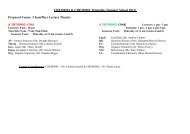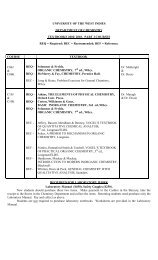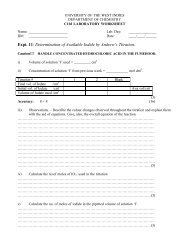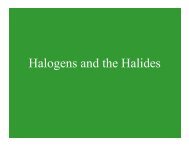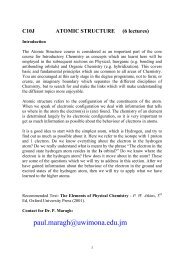O-25 HAIMEA ALTA AND HAIMEA OVUMSERPENTIS,WHAT’S THE DIFFERENCE?Deborah-Ann C. Rowe<strong>Department</strong> <strong>of</strong> Geography <strong>and</strong> Geology, Mona<strong>The</strong> oligopygoids are a group <strong>of</strong> irregular echinoidsunique to the Eocene <strong>of</strong> the Caribbean <strong>and</strong>adjacent regions. <strong>The</strong>se echinoids are the sister group to the clypeasteroids (=s<strong>and</strong> dollars), <strong>and</strong> arerepresented by a number <strong>of</strong> species in the genera Haimea Michelin <strong>and</strong> Oligopygus de Loriol. Bothgenera are locally common in the Eocene <strong>of</strong> Jamaica. <strong>The</strong> difficulty in distinguishing betweenspecies within the genus Haimea has long been documented. Two species are locally common withinthe Middle-Upper Eocene Swanswick Formation, but they cannot always easily be differentiated.Without taking measurements, the only feature that can be used to distinguish Haimea alta (Arnold<strong>and</strong> Clark) from Haimea ovumserpentis (Guppy) is the greater height <strong>of</strong> H. alta. This method issubjective <strong>and</strong> is reliable only in those cases where the test <strong>of</strong> H. alta is highly inflated, as that <strong>of</strong> H.ovumserpentis can also be inflated as well. H. alta may be so inflated as to resemble a fossilized golfball, whereas H. ovumserpentis is generally lower, more elongate <strong>and</strong> pentagonal in outline. Kier’s“Revision <strong>of</strong> the Oligopygoid Echinoids” (1967, Smithsonian Miscellaneous Contributions, vol.152, no. 2, 147 pp.) gives an outline <strong>of</strong> the morphological details which may be used to differentiatebetween the two species, including the shorter petal length <strong>and</strong> greater number <strong>of</strong> ambulacral platesbeyond the petals <strong>of</strong> H. alta. In an attempt to find other ways <strong>of</strong> telling the two species apart, 17measurements each have been made <strong>of</strong> 112 better preserved specimens <strong>of</strong> Haimea from an echinoidlocality in the Swanswick Formation at Beecher Town, in the parish <strong>of</strong> St. Ann, Jamaica. Based onthese measurements, bivariate statistical analyses were carried out in order to seek out the bestmeans <strong>of</strong> identifying each species. Using scatter diagrams <strong>and</strong> regression analysis, the parameters <strong>of</strong>test length, test height, <strong>and</strong> width <strong>and</strong> height <strong>of</strong> peristome, were found to be the most suitable to tellthe two species apartO-26 CRETACEOUS TO EOCENE EVOLUTIONOF CENTRAL JAMAICASimon Mitchell<strong>Department</strong> <strong>of</strong> Geography <strong>and</strong> Geology, Mona<strong>The</strong> Central Inlier exposes a suite <strong>of</strong> latest Cretaceous to Paleocene rocks that formed part <strong>of</strong> anextinct volcanic isl<strong>and</strong> arc system. Detailed mapping <strong>of</strong> the inlier has resulted in a new underst<strong>and</strong>ing<strong>of</strong> the geological history <strong>of</strong> Jamaica. <strong>The</strong> 1 st phase <strong>of</strong> active arc volcanism is represented by <strong>and</strong>esiticlavas, associated volcaniclastic sediments, <strong>and</strong> minor porphyritic basaltic dykes. This complex wasuplift <strong>and</strong> deeply eroded prior to the deposition <strong>of</strong> an inportant onlapping sedimentary successioncomprising the Slippery Rock <strong>and</strong> Guinea Corn formations. Sedimentary analysis <strong>of</strong> this successiondemonstrates the presence <strong>of</strong> a carbonate platform succession <strong>of</strong> restricted rudist-bearing carbonatefacies with associated shallow water clastics deposited closer to l<strong>and</strong>. Renewed volcanism in thePaleocene (with a probable hiatus at the Cretaceous-Tertiary boundary) saw extensive marine <strong>and</strong>terrestrial deposition <strong>of</strong> volcaniclastic s<strong>and</strong>stones <strong>and</strong> conglomerates which culminated in ignimbriteemplacement. This sedimentary succession was strongly deformed by tectonics in the early Eocenewith the formation <strong>of</strong> steep to vertical fold limbs associated with south-westerly verging folds <strong>and</strong>associated thrusting. After a period <strong>of</strong> renewed erosion, the deposition <strong>of</strong> the Yellow LimestoneGroup marked the first stage in the development <strong>of</strong> an extensive carbonate platform that persistedfrom Eocene to Miocene time.44
O-27 PHASE TRANSITIONS AND ORDERING PHENOMENA INAMPHIPHILICMONOLAYERS AT THE AIR/WATER INTERFACEWillem Mulder<strong>Department</strong> <strong>of</strong> <strong>Chemistry</strong>, Mona<strong>The</strong> surface activity <strong>of</strong> molecules such as lipids, proteins <strong>and</strong> fatty acids is associated with their dualcharacter; that is, one part is hydrophobic (“water-fearing”) <strong>and</strong> the other part is hydrophilic(“water-loving”). Such molecules are also called “amphiphiles”. <strong>The</strong> primary requirement for anamphiphile to be surface-active is that the balance between hydrophilic <strong>and</strong> hydrophobic parts besuch that the molecule has its lowest free energy when it is adsorbed at an interface between twoimmiscible bulk phases (water/oil or water/air). <strong>The</strong> amphiphile will then be present as amonomolecular film. Examples include the surfactant films in microemulsions, Langmuir filmsformed by spreading amphiphilic molecules on a water surface, the dense (Langmuir-Blodgett) films<strong>of</strong> chain molecules on solid supports, or the two lipid monolayers facing each other in biologicalmembranes.<strong>The</strong> most common experiment performed on Langmuir monolayers is the determination <strong>of</strong> surfacepressure vs. area isotherms using a film balance 1 . <strong>The</strong> surface pressure Π is defined as the differencebetween the surface tension γ0 <strong>of</strong> <strong>pure</strong> water <strong>and</strong> the surface tension γ<strong>of</strong> the surface covered by themonolayerΠ = γ0 − γ (1)A barrier can be slid across the water surface to change the area accessible to a fixed amount <strong>of</strong>surface-active material. <strong>The</strong> surface pressure can be measured by determining the force on a floatseparating the monolayer from a clean water surface. A typical Π-A isotherm for a <strong>pure</strong> fatty acid orphospholipid is shown in the figure, where two regions can be discerned in which different surfacephases coexist. At large areas the amphiphile behaves like a two-dimensional gas. Upon compressiona plateau is reached, marking the onset <strong>of</strong> 2D condensation <strong>of</strong> the gas into a so-called liquidexp<strong>and</strong>ed(LE) phase. At the end <strong>of</strong> the plateau the entire monolayer is in the LE phase. On furthercompression the lateral pressure again increases steeper until the start <strong>of</strong> a second transition regionwhere the LE phase condenses into a liquid-condensed (LC) phase which is associated withincreased chain ordering. At the end <strong>of</strong> the LE/LC coexistence region there is another steep increasein pressure until the collapse pressure is reached, which marks the transformation to more stablethree-dimensional (micellar) phases.<strong>The</strong> formation <strong>of</strong> LC from LE in the second coexistence region (sometimes called the “maintransition”) can be followed by fluorescence microscopy if one adds a small amount <strong>of</strong> surface activefluorescent dye which is less soluble in the LC compared to the LE phase. Alternatively, one can usethe more recently developed non-invasive technique known as Brewster angle microscopy. <strong>The</strong>micrographs obtained with both techniques reveal that the LC phase exists in the form <strong>of</strong> isolateddomains (sizes ~10µm) which, in the case <strong>of</strong> chiral amphiphiles, change their shape from circles viaellipses to stripes, spirals, triskelions, etc. <strong>The</strong>se have been established to represent equilibriumshapes <strong>and</strong> the result <strong>of</strong> a competition between lateral electrostatic repulsion between the polar (orcharged) head groups <strong>of</strong> surfactants <strong>and</strong> (anisotropic) line tension.45
- Page 1 and 2: _________________________PROCEEDING
- Page 4 and 5: Monday January 11 th 1999__________
- Page 6 and 7: FREE ORAL PRESENTATIONSChemistry Le
- Page 8 and 9: Wednesday January 13 th , 1999_____
- Page 10 and 11: GEOLOGY____________________________
- Page 12 and 13: POSTER PRESENTATIONSDisplayed in De
- Page 14 and 15: P-20 The compatibility of a thiodan
- Page 16 and 17: P-37 Genetic diversity in dasheens
- Page 18 and 19: P-55 Trinidad clays as a potential
- Page 20 and 21: B. Bark beetles (3 species). The ba
- Page 22 and 23: Figure:Population of adult weevils,
- Page 24 and 25: O-4 CONDITIONAL ESTIMATION IN AN EX
- Page 26 and 27: Six growth forms were observed, all
- Page 28 and 29: The difference in coral cover among
- Page 30 and 31: Examination of whole and sectioned
- Page 32 and 33: Ultimately one of the aims of many
- Page 34 and 35: Table:Concentrations of chlorpyrifo
- Page 36 and 37: Table: Half life of Miral 500CS on
- Page 38 and 39: Nucleotide sequence analysis of the
- Page 40 and 41: Regardless of the level of fertiliz
- Page 42 and 43: Various morphological, physiologica
- Page 46 and 47: A complete thermodynamic descriptio
- Page 48 and 49: One of the promising methods of det
- Page 50 and 51: We aim at producing a model which c
- Page 52 and 53: in comparison to the function f giv
- Page 54 and 55: The scripting language described he
- Page 56 and 57: O-36 CRYPTOGRAPHY AND THE INFORMATI
- Page 58 and 59: ABSTRACTS OF POSTER PRESENTATIONS__
- Page 60 and 61: The varied range of effects to the
- Page 62 and 63: P-5 THE USE OF INFORMATION SYSTEMS
- Page 64 and 65: The present maximum phytoplankton a
- Page 66 and 67: P-9 INDIVIDUAL ZOOPLANKTON SPECIES
- Page 68 and 69: The most abundant crustacean captur
- Page 70 and 71: Potamic characteristics include slu
- Page 72 and 73: Preliminary results have indicated
- Page 74 and 75: M. tuberculata was found only at tw
- Page 76 and 77: Thiara granifera is gregarious, pro
- Page 78 and 79: The population of the CLM in Jamaic
- Page 80 and 81: The present studies were undertaken
- Page 82 and 83: P-21 ANTIFEEDANT PROPERTIES OF VARI
- Page 84 and 85: ReferencesClarke-Harris, D.O. (1998
- Page 86 and 87: Mansingh, A., Robinson, D.E. and Da
- Page 88 and 89: P-24 THE NEW JAMAICA SEISMOGRAPH NE
- Page 91 and 92: P-26 JUPITER LANDSLIDE, RIO GRANDE
- Page 93 and 94: P-27 BIOSTRATIGRAPHIC INVESTIGATION
- Page 95 and 96:
P-28 EVALUATION OF MEDIA, METHODS O
- Page 97 and 98:
P-31 PHYSIOLOGICAL ECOLOGY OF TEN P
- Page 99 and 100:
2. Stavely, J.R., Steadman, J.R. 19
- Page 101 and 102:
P-36 IDENTIFICATION, DISTRIBUTION,
- Page 103 and 104:
Todd G. A., Daniels M. J. and Callo
- Page 105 and 106:
P-42 QUANTIFICATION AND IDENTIFICAT
- Page 107 and 108:
P-46 A STUDY OF VIBRIO SPECIES IN R
- Page 109 and 110:
P-49 INDOOR LEVELS OF NO2 MEASURED
- Page 111 and 112:
Qualitative assessment of these sig
- Page 113 and 114:
P-55 TRINIDAD CLAYS AS A POTENTIAL
- Page 115 and 116:
The procedure was applied to the Pi
- Page 117:
117




